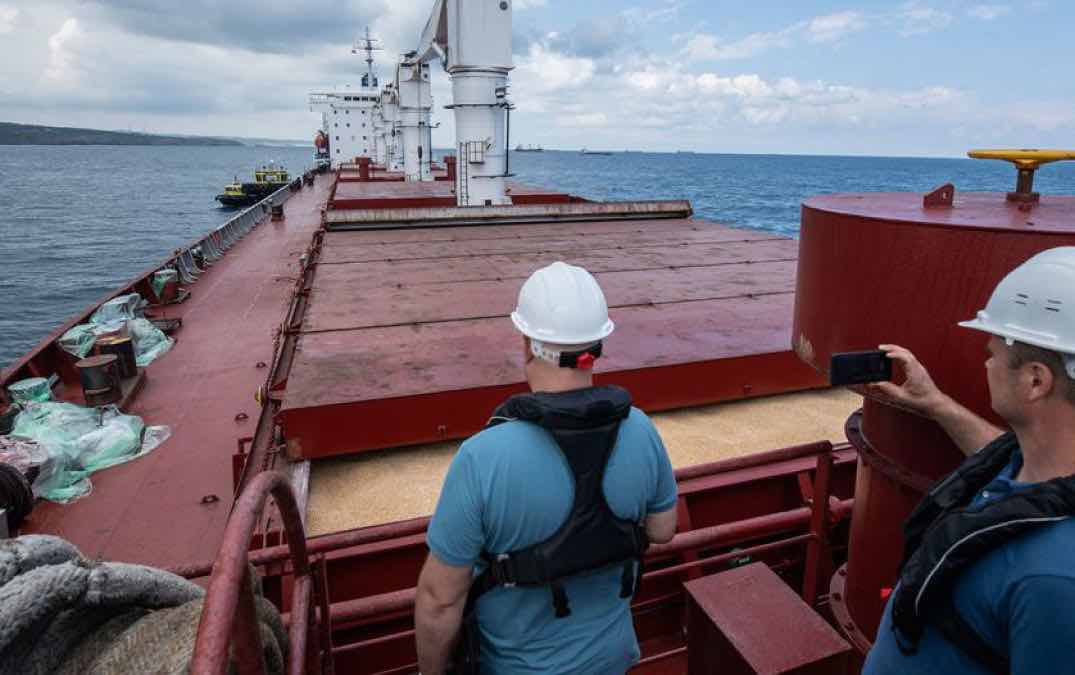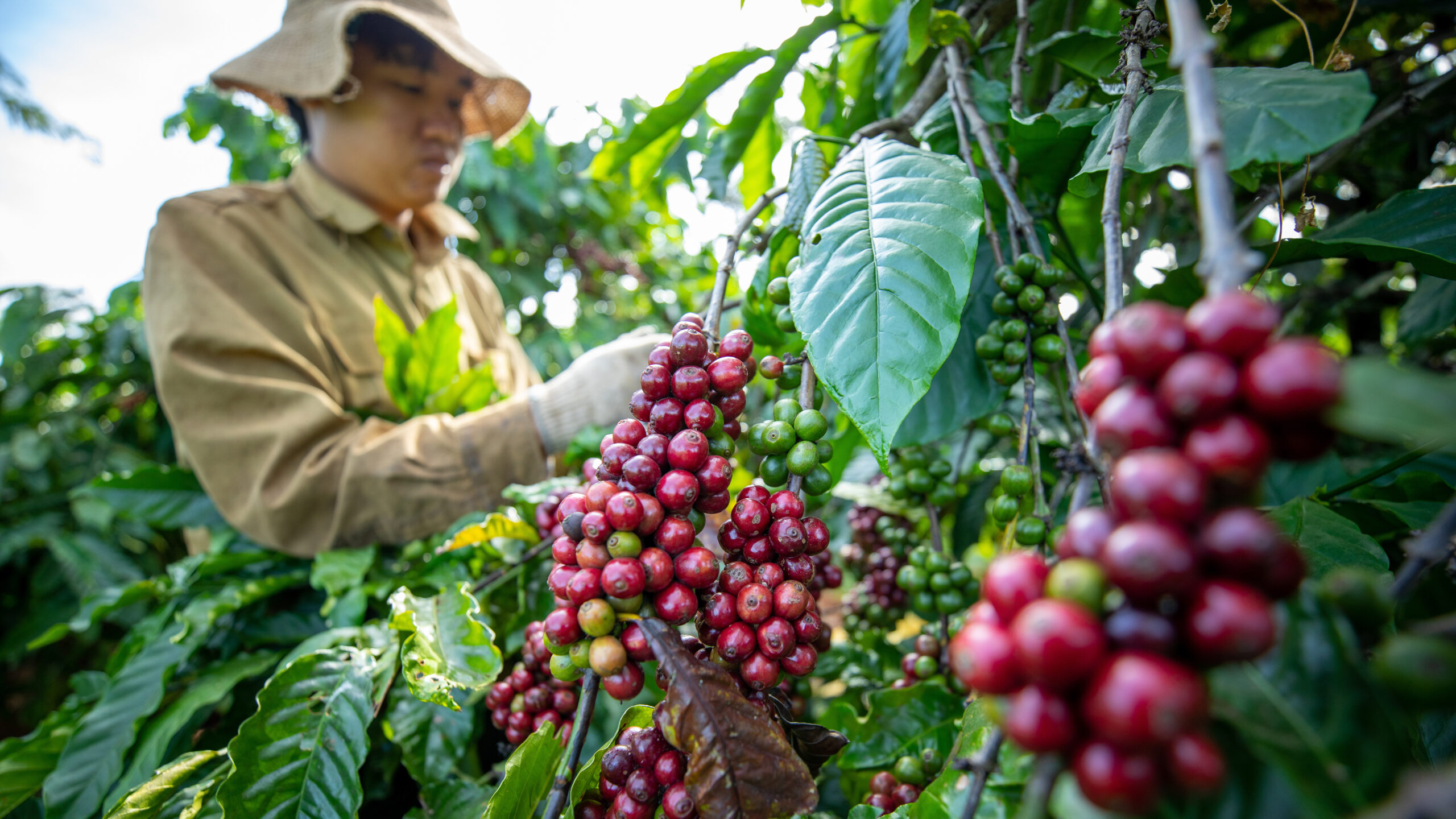When Russian troops invaded Ukraine one year ago, the war appeared to pose a grave threat to global food security.
The conflict could hardly have come at a worse moment. Even prior to the war, global supplies of key staples were tight; ending stocks of wheat, maize and soybeans were at their lowest levels for many years and prices were high compared to 2020 levels—lingering effects of the COVID-19 pandemic. The outbreak of war between two of the world’s key agricultural producers jeopardized more than a third of world wheat trade, 17% of world maize trade, and almost 75% of world sunflower oil trade. Within a week of the invasion, prices of wheat futures had jumped almost 60%, while corn and soybean prices were up over 15% (Figure 1). Ukraine found its Black Sea ports effectively blockaded, sharply limiting its ability export its 2021 crops, and the planting and harvest of its 2022 crops disrupted. The world faced the possibility of another food price crisis with potentially devastating consequences, following on the heels of the pandemic’s global economic disruptions.
Figure 1
Yet as the war continued through 2022, international markets adjusted and adapted, and—while high prices and other problems persist—the worst-case scenarios for agricultural trade and food security were largely averted.
By August 2022 prices had fallen back to pre-war levels. Importers adjusted to market disruptions and found alternative suppliers. The partial re-opening of ports through the Black Sea Grain Initiative helped facilitate additional exports from Ukraine. In May, price volatility levels for wheat and maize reached the highest levels in more than 10 years, but by early February 2023 they had fallen back to within historical ranges. Lastly, the war precipitated an increase in global humanitarian efforts to help mitigate its impacts. For example, the World Food Programme reported that contributions from all sources in 2022 exceeded $14.2 billion, up almost 48% from 2021 levels.
Now, with no end to the war in sight, what lessons should we take away from its food system disruptions to date? Should we no longer be concerned about the war's impact on markets and food security? This post reviews the experiences of the past year, and the uncertainties that remain about the future.
Markets have shown resiliency
Why did market prices fall? The invasion sparked high uncertainty in agricultural markets. First, Northern Hemisphere winter wheat crops had already been planted the previous fall, so producers were limited to how much additional wheat could be planted. Second, the war appeared likely to disrupt Ukraine and Russian exports, creating a major global supply problem.
Yet the worst fears of persistent global shortages did not come to pass (Figure 2a). Ukraine’s wheat exports have fallen dramatically, by an estimated 5.3 million metric tons (a 28% decline) from 2021/22-2022/23, as have Argentina's exports, due to drought that has sharply reduced its wheat harvest. But Russian exports are up strongly due in part to a record wheat crop. That increase, combined with large crops in Canada and the European Union in 2022, equals a rise in projected combined exports exceeding 25 million tons—offsetting the export declines in Ukraine other regions. Meanwhile, Australia's wheat exports continue to be robust, narrowly setting a record with an increase of 500,000 metric tons over last year, following back-to-back record export levels in 2020/21 and 2021/22.
Global maize exports show a slightly different picture (Figure 2b). Ukraine maize exports in 2022/23 are down an estimated 4.5 million tons less from 2021/22, but that is dwarfed by an estimated decline in United States exports of almost 14 million tons—in part reflecting a reduced 2022 harvest and a strong dollar that has made U.S. maize less competitive in world markets. EU maize exports are down as well, declining by 3.8 million tons. The declines are only partially offset by increased exports from Brazil and Argentina. Higher maize prices have reduced global demand and caused some importers to seek alternative feedstuffs such as broken rice. The U.S. Department of Agriculture projects a fall in global feed demand of almost 23 million metric tons (about 2.8%).
Figure 2a
Figure 2b
As crop production forecasts for wheat and maize brightened in the second half of 2022, and Russian wheat exports rebounded, market prices began to fall. In addition, markets remained remarkably resilient as importing countries shifted suppliers to meet demands. At the same time, global domestic wheat consumption in 2022/23 is projected to be largely unchanged from 2021/22 levels despite high prices, due in part to household safety net programs in some wheat importing countries of the Middle East and North Africa (MENA).
While export restrictions exacerbated prices of grains, oilseeds, and other agricultural products in the months following the start of the war (as discussed in previous blog posts), by June many of the more binding measures had been removed or at least curtailed. That trend, combined with the partial reopening of Ukraine's Black Sea ports (where more than 22 million tons of grains and oilseeds have been shipped since August 1), has helped to add to world supplies.
The impact of the war on Ukraine's agriculture to be felt even more sharply in 2023
But it is Ukraine itself that has felt the war’s most direct and continuing impacts on agriculture. The war has already affected three successive crops:
2021 crops: Much of the previous year’s harvests had not yet shipped when the invasion occurred, and could only be exported via slow and costly overland routes through the west. Though the development of so-called Solidarity Lanes (truck, rail, and barge routes through the EU) helped alleviate some of the backup, it was not until the Black Sea ports were partially reopened in August through the Black Sea Grain Initiative that agricultural exports began to approach more normal levels (Figure 3).
Figure 3
2022 crops: In the meantime, producers struggled to plant, harvest and market 2022 crops due to the direct impacts of the war itself and the indirect impacts of higher input costs such as energy and fertilizer prices. Production fell dramatically (Figures 4a, 4b), with wheat and maize harvests both down 36%.
While efforts to facilitate export transportation have helped move more production to foreign markets, the associated costs have been high. Multi-modal (truck, train, barge) exports through the west are costly, while long inspection times and resulting demurrage charges have added significant costs to shipping through Black Sea ports. These costs have been largely absorbed by Ukraine producers in the form of lower prices.
2023 crops: Those low producer prices, combined with high input costs, have discouraged planting for 2023 crops, and production is expected to drop even further.
Private estimates suggest Ukraine's grain harvest could fall by as much as 35-40 million tons in 2023, including 12-15 million tons of wheat and 15-17 million tons of maize. Wheat supplies for 2023/24 (2023 production plus year end stocks from the 2022/23 marketing year) are likely to be almost 30% below 2022/23 levels and 45% below 2021/22 levels (Figures 4a, 4b). Expected maize supplies for Ukraine for 2023/24 could be 36% below this year's level and 53% below 2021/22 levels.
Figure 4a
Figure 4b
Impacts of fertilizer sanctions less clear
Sanctions imposed on Russia and Belarus in response to the invasion have disrupted energy markets and, relatedly, fertilizer supplies. While sanctions on Russia have explicitly exempted food and fertilizer, the country’s fertilizer exports have lagged below pre-war levels, particularly due to the cutoff of anhydrous ammonia shipped via pipeline from Russian factories to port facilities in Odesa. Potash exports from Belarus have also dropped, as they are not exempt from current sanctions and barred from export through EU ports on the Baltic Sea. The impacts are potentially significant since much of world depends on Russia (and Belarus) for imports of nutrients.
Yet energy and fertilizer prices have paralleled those of grains and oilseeds—peaking in the spring and then falling through the rest of 2022 as global production and markets adjusted to the shortfalls. The experience of major importers like Brazil and Indonesia suggest that as was the case with grain, markets have been very resilient, allowing them to find alternative suppliers (for example, Canada potash exports). This has allowed many producers to meet their nutrient needs, albeit at persistently higher costs—despite the 35% to 50% drop in fertilizer prices since May 2022, prices remain 80% to 100% above 2020 levels. In addition, producers have shifted to less nitrogen-intensive crops like soybeans. For many producers in low income countries, however, high fertilizer prices have made input purchases less affordable, potentially affecting yields.
Conclusions
With no end to the war in sight and threats of further escalation, uncertainty continues to hang over agricultural markets. Supplies are tight. Globally, estimated ending stocks for 2022/23 are at the lowest levels since 2007/08 for wheat and 2012/13 for maize and soybeans. Reduced plantings in Ukraine mean that the world will need to produce additional grains and oilseeds to help rebuild stocks and moderate price levels. Luck has played some role in events; in the year since the invasion, the combination of good weather and strong producer supply response has kept market prices from rebounding back to the high levels of early 2022. Tight stocks will mean increased price volatility, particularly during periods of uncertainty such as planting times and growing seasons in the Northern Hemisphere. In the meantime, uncertainty over events like the renewal of the current Black Sea Grain Initiative (currently scheduled to expire in March) will continue to roil markets.
Any of these uncertainties could lead to future market disruptions or other problems that bear continued, close monitoring. The main lesson of 2022 is that global markets have generally worked well when not impeded by government actions like export restrictions. Hopefully that will be a lesson learned for countries as the world enters another year of global impacts from the war in Ukraine.
Joseph Glauber is a Senior Research Fellow with IFPRI's Markets, Trade, and Institutions Division. Opinions are the author's.







